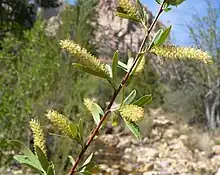Salix gooddingii
Salix gooddingii is a species of willow known by the common name Goodding's willow, or Goodding's black willow. It was named for its collector, Leslie Newton Goodding.[1]
| Goodding's willow | |
|---|---|
 | |
| Scientific classification | |
| Kingdom: | Plantae |
| Clade: | Tracheophytes |
| Clade: | Angiosperms |
| Clade: | Eudicots |
| Clade: | Rosids |
| Order: | Malpighiales |
| Family: | Salicaceae |
| Genus: | Salix |
| Species: | S. gooddingii |
| Binomial name | |
| Salix gooddingii C.R.Ball[1] | |
Salix gooddingii is native to the southwestern United States and northern Mexico, where it grows in moist and wet habitat in many types of habitat from mountains to desert. It is a common riparian species. It is a tree growing to 3 to 30 m (9.8 to 98.4 ft) tall, with thick, furrowed, shreddy bark and many thin branches. The leaves are up to 13 cm long, generally lance-shaped, and finely serrated along the edges. The young leaves are coated in hairs. The inflorescence is a catkin of flowers up to 8 cm long.
References
- S. gooddingii was first described and published in Botanical Gazette; Paper of Botanical Notes, 40(5): 376 (-377; t. 12, figs. 1-2). 1905. Crawfordsville, Indiana and Chicago, Illinois. "Plant Name Details for Salix gooddingii". IPNI. Retrieved September 4, 2010.
originally written as "gooddingi"; Distribution: Nevada; Collector: L. N. Goodding; Locality: Muddy Creek: ditchy banks (Muddy Creek is a tributary of the Virgin River, which flows into the Colorado in Lincoln County, in extreme southeastern Nevada); Collection Date: 1902-5-2
External links
 Media related to Salix gooddingii at Wikimedia Commons
Media related to Salix gooddingii at Wikimedia Commons Data related to Salix gooddingii at Wikispecies
Data related to Salix gooddingii at Wikispecies- Jepson Manual Treatment
- US Forest Service Fire Ecology
- Salix gooddingii in the CalPhotos photo database, University of California, Berkeley
- "Salix gooddingii". Calflora. Berkeley, California: The Calflora Database.
- "Salix gooddingii". Plants for a Future.
This article is issued from Wikipedia. The text is licensed under Creative Commons - Attribution - Sharealike. Additional terms may apply for the media files.
